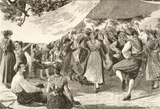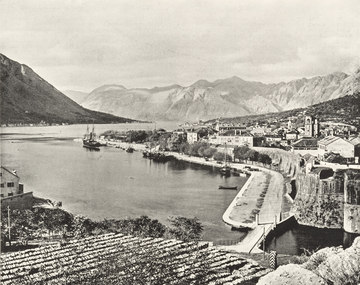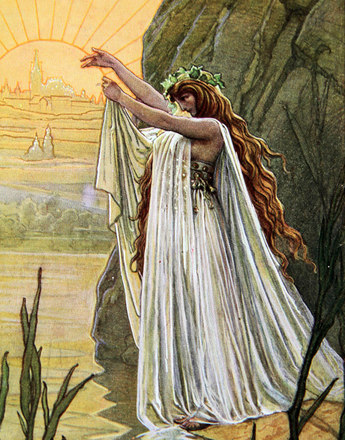From Illyrism to Yugoslavism: competing concepts for a southern Slav nation
-

B. Bukovac: South Slav dance (“kolo”), illustration, 1892
Copyright: Schloß Schönbrunn Kultur-und Betriebsges.m.b.H./Fotograf: Alexander E. Koller
-

Blaho Bukovacs: The Illyrian poets, illustration based on the curtain of the Zagreb National Theatre, illustration
Copyright: Schloß Schönbrunn Kultur-und Betriebsges.m.b.H./Fotograf: Alexander E. Koller
National unification ideologies developed on the principle of a common language for the southern Slavs. One of the contentious issues was whether it should be led by Serbs or Croats. The question of the inclusion of the Slovenes also remained to be solved.
At a time of national awakening, the idea arose in scholastic circles of combining the numerous Slavic dialects into a shared official language. The long-term aim was the creation of a southern Slav nation, given the antique-sounding name ‘Illyric’. It was hoped that cultural and confessional differences could be overcome, even though the historical and cultural development of the southern Slav peoples had been very different.
The idea of Illyrism, discussed hitherto only in academic circles, was given a political basis through the reorganization of Europe by Napoleon. Ignoring historical boundaries, he combined Carniola, Gorica, Trieste, parts of Carinthia and Croatia into a single unity known as the Illyrian Provinces.
Although this Napoleonic territory was short-lived – the Illyrian Provinces existed only from 1809 to 1813 – the idea remained latent. The Illyrian idea saw the Croats as the leading element, as they already had a history as a state. The imagined ‘greater Croatia’, now called the Kingdom of Illyria, would include not only Croatia, Slavonia and Dalmatia but also Bosnia, Istria and the Slovenian territories, the Slovenes being known in Croat as ‘mountain Croats’. The creation of Illyria within the federalist Habsburg Monarchy was one of the main demands of the Croats in 1848. After the defeat of the revolution, this demand remained wishful thinking.
From the mid-nineteenth century the idea of Yugoslavism also developed, its long-term aim being the amalgamation of the various ‘branches of the southern Slav nation’. The notion first took root at the cultural level. In 1850 the Vienna Agreement between Croat, Serb and Slovene intellectuals was adopted as a declaration of intent to harmonize the southern Slavic languages and form a standard Serbo-Croat language.
The Croat leadership of the southern Slavs shifted increasingly in favour of the Serbs. This was due to the new assurance of Serbia, which had in 1878 gained independence from the Ottoman Empire to become an important regional power in the western Balkans. The Serbian version of Yugoslavism was interpreted thereafter increasingly in the form of a ‘greater Serbia’.
The rivalry between Croats and Serbs stymied the unification process. Cultural differences became apparent. Catholicism was the identifying characteristic of the conservative Slovene and Croat nationalists, which clashed with the Christian orthodox traditions of the Serbs. Yugoslavism did not experience a renaissance until around 1900, when a new generation took over the reins. Young, free-thinking liberal groups no longer saw religion as an obstacle. The new ‘populist’ nationalism was also more radical, and militant extremism was widespread among students.
In 1905 the Serb and Croat parliamentarians from different parties in both halves of the empire formed a ‘Croat-Serb coalition’. In the interests of finding a way out of the impasse in the southern Slavic position in both Cisleithania and Transleithania, they sought to put aside the old rivalries between Croats and Serbs. As a reaction to the German national centralism in Cisleithania affecting the Slovenes and the uncompromising Magyarization policy affecting the Croats and Serbs, the Yugoslavist idea also attracted more and more supporters among the moderates in the political mainstream in Zagreb and Ljubljana. The idea of complete separation from the increasing constraints of the Habsburg Monarchy matured as Yugoslavism was transformed from a cultural notion to a national unification movement.
Translation: Nick Somers
Hösch, Edgar: Geschichte der Balkanländer. Von der Frühzeit bis zur Gegenwart, München 1999
Rumpler, Helmut: Eine Chance für Mitteleuropa. Bürgerliche Emanzipation und Staatsverfall in der Habsburgermonarchie [Österreichische Geschichte 1804–1914, hrsg. von Herwig Wolfram], Wien 2005
Štih, Peter/Simoniti, Vasko/Vodopivec, Peter: Slowenische Geschichte. Gesellschaft – Politik – Kultur, Graz 2008
Suppan, Arnold: Die Kroaten, in: Wandruszka, Adam/Urbanitsch, Peter (Hrsg.): Die Habsburgermonarchie 1848–1918, Band III: Die Völker des Reiches, Wien 1980, Teilband 1, 626–733
-
Chapters
- The Croats in the Habsburg Monarchy
- ‘Loyal rebels: the role of the Croats in the 1848 revolution
- The question of autonomy: the Croats caught between Vienna and Budapest
- The Serbs in the Habsburg Monarchy
- ‘Serbs all and everywhere’: the Serb national programme
- The Bosnians in the Habsburg Monarchy
- Sharia under the Double Eagle: Austria-Hungary and the Bosnian Muslims
- From Illyrism to Yugoslavism: competing concepts for a southern Slav nation
- Friend or foe? The positions of the southern Slavs in the First World War
-
Chapters
- The drive for unification
- The radical German nationalists and their attitude to the Habsburg Monarchy
- The concept of ‘German Central Europe’
- Together we are strong: Pan-slavism and "Slavdom"
- The rise and fall of Austro-Slavism
- "Two branches of one nation" – Czechoslovakism as a political programme
- Viva l’Italia! Italian irredentism and the Habsburg Monarchy
- From Illyrism to Yugoslavism: competing concepts for a southern Slav nation
- Élyen a Magyar – long live the Magyars! Hungarian Magyarization policy



